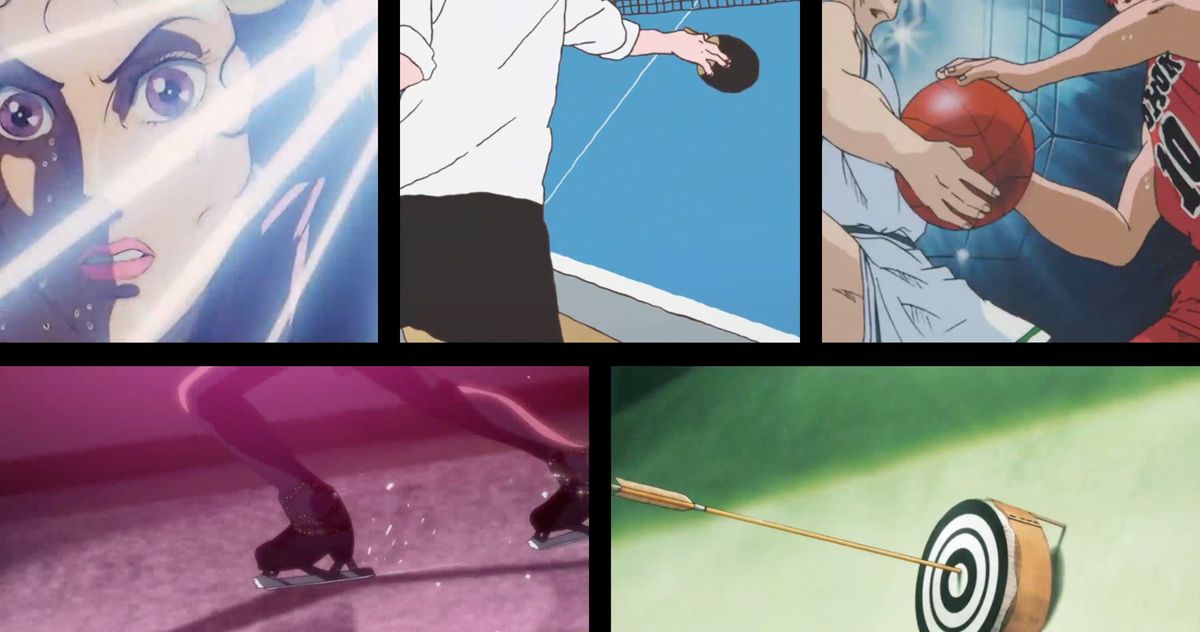Sports
The 13 Best Sports Anime to Keep Your Olympic Endorphins Going

This year’s Summer Olympics have been a hit. The ratings are high, the spectacle is spectacular, and the kayak cross is cool — among other wins. How to keep this momentum going after the Olympics end this weekend, you ask? Animation produced in Japan is the answer. The best sports anime tend to follow a loose pattern: An individual (typically young, but not always) encounters some crisis right around the same time they also encounter [insert sporting event] and fellow athletes who either introduce them to the sport or complicate their relationship to it — teammates, mentors, rivals, narrative foils, you name it. These titles are propelled by sportsmanship, hype-worthy animated athleticism, and characters who feel like they couldn’t exist in any other context, like the brash goofball Hanamichi of Slam Dunk or the klutzy but driven Hiromi of Aim for the Ace! If the Olympics have reminded you how much you love watching athletes fully commit their bodies to, say, table tennis, be sure to add these sports anime (including Ping Pong: The Animation!) to your watch lists.
Perhaps the slowest-paced title on this list, the archery drama Tsurune is a study in tension and release. Though teams compete and friendly rivalries persist, in this show, the target is the soul, not the scorecard. In the hands of the members of Kazemai High’s archery club, a Japanese longbow, or yumi, is a tool for self-improvement, a reminder to breathe properly, and an addictive thrill to listen to when an arrow is loosed. That ethos extends to the visuals produced by the acclaimed Kyoto Animation studio and directed by Takuya Yamamura: Practically every time an arrow flies in the series, it’s animated in lingering slow motion — in arcs propelled by the strings of longbows and washed in hazy sunshine — until the darts hit their marks, or don’t. Often, they’re accompanied by stylized embellishments, like leaves or rippling special effects, that externalize the zen that the archers seek. After a certain point in the series, you get used to the idea that the most important thing to the club members isn’t winning a tournament but taking as many shots as they possibly can. (Streaming on Crunchyroll, dubbed and subtitled.) —Eric Vilas-Boas
For my money, Takehiko Inoue’s ode to basketball is the greatest sports anime ever made. First debuted as a manga in 1990 and then as an anime by Toei Animation in 1993, Slam Dunk follows the exploits of Hanamichi Sakuragi, a redheaded ne’er-do-well, as he weasels his way into the Shohoku High basketball team in an attempt to impress a girl only to thoroughly fall in love with the sport. As we inch deeper into the series, Slam Dunk mirrors Sakuragi’s gradual acceptance as a team player and widens its focus to his teammates, ultimately becoming a story about a group of individuals trying to transcend their doubts and histories through the game they love. It’s zany, melodramatic, and genuinely moving in equal measure, and though the series is about three decades old, this is the perfect time to get into it. A stand-alone 2021 film adaptation, The First Slam Dunk, which gorgeously depicts a pivotal chapter in the series with modern animation tech, is now available on Blu-ray. (Streaming on Crunchyroll, subtitled.) —Nicholas Quah
Though the show was made 50 years ago, Tomorrow’s Joe still packs a punch, and newer titles like Megalo Box and Hajime no Ippo wouldn’t exist without it. Anime and manga creators regularly genuflect at the gloves of Joe Yabuki, a character who unsteadily rises from fighting in the slums of Tokyo to boxing on world stages. The manga by Asao Takamori and Tetsuya Chiba and the anime directed by Osamu Dezaki, who began his series-directing career with this show, are both massively influential for their art style, for establishing a template that numerous shonen sports titles would follow, and for their use of dramatically stylized “postcard memory” freeze-frames — the use of an action still amid the animation to capture a powerful emotion. Combined, Joe’s dynamic drive, the gritty setting among the underclass of ’60s-era Tokyo, and the animation’s strategic mix of motion and stillness, all form an indelible whole. (Streaming — in part — on YouTube, subtitled.) —E.V.B.
This short film may have been produced at the Madhouse anime studio, but it’s directed by Kitarō Kōsaka — better known as the animation director of Studio Ghibli’s Spirited Away and Princess Mononoke. Fired up by his own interest with the sport, Kōsaka suggested that Hayao Miyazaki try directing a cycling anime, and he replied, “I don’t want to do it, but go ahead.” Nasu is just 47 minutes long, but it gamely dramatizes the struggle and passion of Pepe Benengeli, a cyclist speeding through his home region while on a long-distance, multistage bike race, the Vuelta a España. Pepe’s thoughts and flashbacks are interspersed with bucolic shots of Spanish countryside and — in the final sprint to the finish line — grotesquely twisted facial expressions. There are other cycling anime, like Yowamushi Pedal, but Nasu’s hints of Ghibli give it a competitive edge. A sequel, Nasu: A Migratory Bird With Suitcase, is also worth a look if you like Summer in Andalusia. (Available via Amazon Prime Video, subtitled.)—E.V.B.
Unlike some of the other titles on this list, Birdie Wing is an original series instead of an adaptation, and its vibe is a lot more self-aware. It often feels more constructed for anime fans who happen to have a passing interest in golf than for golf fans who might try out an anime. (There’s an extended riff on one character’s obsession with gunpla model kits in the second episode, complete with a shot of an RX-78 kit from Mobile Suit Gundam.) Golf wizard and protagonist Eve, for example, starts the series as one of the most impressive golfers in the world. It’s when she meets a rival worthy of her talent that she begins to change and rediscover meaning in the sport. Some anime critics have wondered if Birdie Wing’s popularity sparked a “golf-anime renaissance” — pointing at several golf series that followed in its footsteps. (Streaming on Crunchyroll, subtitled.) —E.V.B.
Listen, Johnny Weir is a fan, so obviously this is going to be included. Sayo Yamamoto and Mitsurou Kubo’s anime has been a rip-roaring hit since its release in 2016, and over the years, the series has been lauded for its storytelling choices — most notably, its rendering of protagonist Yuuri Katsuki’s struggle with anxiety, which is thoughtfully presented as an aspect of the character from the beginning, along with the relative casualness in how it depicts his same-sex relationship with the series’ other central character, Victor Nikiforov. All those things are supported by a strong foundation of genre delights that’s incredibly fun to watch. Featuring intricate animation work by the studio MAPPA, which brings to screen choreography by Kenji Miyamoto, Yuri!!! On Ice is widely considered a fairly faithful depiction of the ice-skating world. In fact, it even pays homage to several real-world pros, including Weir himself. (Streaming on Crunchyroll, dubbed and subtitled.) —N.Q.
Masaaki Yuasa is one of modern anime’s great visionaries — a director capable of alchemizing devil-men, natural disasters, mermaid creatures, and Japanese folk-rock musicians from the 14th century into reliably batshit entertainment. In Ping Pong: The Animation, he set his sights on the wildest indoor sport of all, adapting Taiyō Matsumoto’s manga into a heatedly penciled 11-episode series. At the story’s heart are two very different friends, Peco and Smile, who strive to battle for ping-pong dominance at the national tournament. In matches, under Yuasa’s characteristic direction, the competitors warp and pretzel as the animation’s focus bends around the ball, the camera following it as the competitors attempt to do the same. Though the animation is precise and well produced, the art style has an intentional sketchiness to it — a reflection of the immaturity of the characters emphasized by its madcap J-rock soundtrack. Ping Pong seems to be saying that there’s something juvenile in watching two boys smack balls back and forth, but also that experiencing their joyous delirium is worth it. (Streaming on Crunchyroll, dubbed and subtitled.) —E.V.B.
As Players showed us and Challengers reminded us, having the hots for your fellow players is practically a requirement of playing tennis. That’s what the plucky Hiromi learns on her way to tennis glory in this sports romance directed by Osamu Dezaki and based on the manga by Sumika Yamamoto. Aim for the Ace! became a template-setting standard for anime and manga geared toward young women; Neon Genesis Evangelion creator Hideaki Anno loves it, and he borrowed its title for — of all things — a robot anime. It’s also a surprisingly emotional watch for a show made in the early ’70s with the barest scraps of animation resources. (In crowd shots with more than three or four people, the heads often resemble blank circles with the occasional eye thrown in for good measure.) Nonetheless, Hiromi’s scenes and her development from unrefined talent to practiced competitor more than make up for it. Aim for the Ace! Another Match, the shorter and higher-budgeted second season, which aired about 15 years after the first, is a much smoother watch, and you can probably skip right to it. (Available on Blu-ray, subtitled.) —E.V.B.
Now, Prince of Tennis is not the most grounded tennis anime out there. In fact, given the abundance of special moves with names like “Zero Shiki Drop” and “Boomerang Snake,” only some of which are physically possible, it’s probably closer to a fantasy series than anything else. I’d also concede that it’s not even necessarily the best anime that deals with tennis; you don’t have to look far for arguments giving that designation to Baby Steps or Aim for the Ace! But Prince of Tennis is an old-school classic, a bombastic joyride that’s filled with huge personalities and completely bonkers face-offs. If you squint, you can sorta see where Challengers’ manic weirdo energy comes from. (Streaming on Crunchyroll, dubbed and subtitled.) —N.Q.
The setup for Run With the Wind is nuts: Under false pretenses, a fourth-year college student cons nine dudes to dorm with him on the promise of free meals and cheap rent; the only catch is that doing so signs them up to be in the school’s running club. Such a deception would be legally actionable if it weren’t a sports anime. The team’s goal? Run the real-life Hakone Ekiden relay marathon — a grueling race spanning two days, ten legs, and nearly 220 kilometers between Tokyo and Hakone, Japan. All ten of the team’s runners are motivated differently, from Haiji, the student who brought the team together after a nasty injury in his leg, to Kakeru, an experienced star runner who gradually warms to his new teammates. The runner’s high they discover is infectious. (Streaming on Crunchyroll, subtitled.) —E.V.B.
Ah, the beautiful game. Soccer (or as it is known just about everywhere else, football) remains the most popular sport on the planet, so it makes complete sense that Yōichi Takahashi’s Captain Tsubasa is now among the most enduring media franchises ever made. First introduced as a manga in 1981, the series as a whole rides shotgun with Tsubasa Oozora, an 11-year-old kid who yearns to be the best player in the world, as he works his way up the ladder of international soccer from local phenom to Olympics competitor. Think of it as a grand tour of the sport’s culture! Tsubasa has spawned numerous adaptations over the decades, many of which are relatively hard to access, but its most recent 2018 iteration, produced by David Studios and directed by Toshiyuki Kato, which depicts the “Junior Youth Arc” within the manga, is now available in a bunch of places. Plus, it’s generally considered to be pretty good! (Streaming on Crunchyroll, dubbed and subtitled.) —N.Q.
One of the newer sports anime on this list to break out globally, Haikyu!! centers on two volleyball players — Shoyo Hinata, an energetic but inexperienced short king, and Tobio Kageyama, a skilled but taciturn player — who start out as sorta-kinda rivals but become close partners as each realizes they unlock something in the other. Spiritually, there’s a lot of commonalities to draw between this series and Slam Dunk, right down to Hinata’s orange-red hair, but Haikyu!!’s particular spark lies with its extravagant openness in being about one’s love for a sport. It’s also super sweet! And here’s a bonus for the Olympics heads: Haikyu!! was all over this year’s Japanese volleyball matchups. The anime’s fandom was well represented throughout the crowd, and its theme song was played out loud whenever the Japanese national team took the court. Even more incredible was the fact that Japan had to face Argentina in the group stages, a matchup that replicates a pivotal event in the manga. (Streaming on Crunchyroll and Netflix, subtitled.) —N.Q.
Yeah, yeah, we know. What’s this doing here? The Olympics doesn’t have any car racing! Well, friends, that is a mistake, because it should. Bending a vehicle to your will is a feat of human athleticism (as any thirst-trap workout video by a Formula One driver can attest), and since the Olympics has been adding new sports in recent cycles, might I suggest throwing a bit of drifting into the mix? If that ever came to be, Initial D would be the style guide. Shuichi Shigeno’s street-racing opus has one of the funnier opening gambits committed to paper: A teenager, Takumi Fujiwara, inadvertently develops prodigious racing skills after years of delivering tofu on winding mountain roads, which he takes to Japan’s various street-racing circuits in a bid to realize his automotive destiny. These days, Initial D can look a little dated with its semi-3-D racing sequences that evoke the original PlayStation’s graphics, but its influence ran far and wide. Its dance-music soundtrack is still a banger. You can see obvious traces of it in The Fast and the Furious: Tokyo Drift, itself an unlikely cultural touchstone. And for years, Initial D helped drive a boom in interest around Fujiwara’s car, a Sprinter Trueno that’s part of the Toyota AE86 series. (Streaming on Hulu, dubbed and subtitled.) —N.Q.









